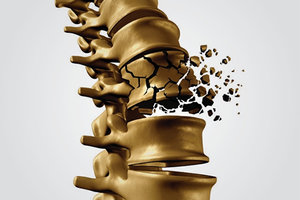As chiropractic physicians, our focus is the neuromusculoskeletal integrity of the body – primarily the spine. Our primary modality is the controlled manipulation / adjustment of the articular dysfunction to restore normal mechanics, improve function, and promote balance and health. Beyond the adjustment, we have a host of options we can use to augment our treatments – therapy modalities, massage, acupuncture, traction, rehab, etc.
However, with any treatment, there are always indications and contraindications to be considered – for our profession, acute fracture is arguably a big contraindication to mobilization. Here are a few simple tests to help detect a vertebral compression injury.
"The Tuning Fork Test"
A quick survey of several of my colleagues revealed that the simple "tuning fork test" – putting the base of a 128cps tuning fork on a bony prominence to elicit pain – is a quick screen for fracture.
Bowel / Bladder Control
 But there is a lot more to evaluating the spine for fracture. One good screening test during interview is, "Have you had any loss of bowel or bladder control?" A positive response is indicative of cauda equina syndrome and cause for immediate neurologic workup.
But there is a lot more to evaluating the spine for fracture. One good screening test during interview is, "Have you had any loss of bowel or bladder control?" A positive response is indicative of cauda equina syndrome and cause for immediate neurologic workup.
Rust's Sign
When a patient presents holding their head up with one or both hands, this should be a big red flag. This suggests significant cervical instability; the patient should be referred for imaging and orthopedic assessment ASAP. Evan's text also notes that a patient lying on their back who needs to use their hand to lift their head can also be considered positive for this sign; however, it may also indicate severe sprain.
Spinal Percussion
"Traumatic injuries to the lumbosacral spine are among the most common causes of disability following trauma." This could be from a hyperflexion injury or flexion and rotation. Vertical impact can cause a burst fracture. Spinal percussion of the spinous processes producing localized pain is an indicator of spinal fracture or severe sprain – but the official diagnosis must be made radiographically. Follow-up percussion of the paravertebral soft tissues causing pain is an indicator of myofascial trigger points.
The Squish Test
Pelvic fractures are often grossly obvious due to deformity. The squish test is performed with the patient lying supine and pushing down and lateral on the ASIS – pain indicates a positive test and damage to the posterior SI ligaments.
The Back Pain Inducing Test
Recently, I also found this topic referenced on the ChiroUp blog. It referenced the "back pain inducing test" and noted the test would be considered positive if the patient had back pain and could not:
- Change position from sitting on the edge of a table to lying supine
- Roll from supine to the right or left
- Rise from lying supine to sitting up with the legs still on the bench
If any of the above is positive, you should screen for osseous vertebral injury.
Your Most Important Diagnostic Ally: The Visual Exam
Perhaps the most important part of this, or any, exam is the interview. It has been said that the patient will tell you what is wrong with them if you do a good interview – the examination is only to confirm what you already suspect.
Watch the patient. Look for clues to how they move or protect from movement to avoid pain. Always remember to document findings – positive or negative; always note where the pain goes. Is it in the back, the buttock or the leg? Does it go down to the knee or foot? Does it cause tension or pulling up into the neck?
Such notes are invaluable when documenting your patient's complaints and the extent of the injury or irritation. These extra notes help document the severity of the patient's complaints, and then on follow up will show the progressive response to your care. And as I've said repeatedly, this extra documentation can also help make the difference if you must justify your diagnosis to an insurer or third party.
Resources
- Evans RC. Illustrated Essentials in Orthopedic Physical Assessment St. Louis, MO: Mosby, 1994.
- Hammer W. "Use of the Straight Leg Test for Upper Extremity Involvement." Dynamic Chiropractic, Nov. 17, 1997.
- The Back Pain Inducing Test. ChiroUp blog: https://chiroup.com/vertebral-fractures-new-chiropractic-test/.





